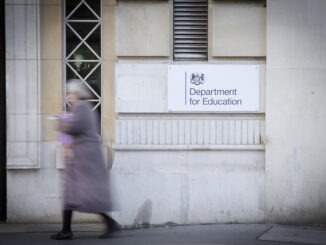
After plans to use ozone machines to disinfect Welsh classrooms was recently abandoned, EdExec wonders what the solution to air safety in schools might be
The Welsh government confirmed last month that they were abandoning the use of ozone machines to disinfect classrooms after a review found that they were potentially ‘highly harmful’ to children. Welsh ministers had previously announced they would spend £3.31m on 1,800 new ozone machines developed by Swansea University – they then U-turned and said that this cash would, instead, be used in schools and colleges to improve ventilation. At the time Swansea University defended the safety of the machines.
However, the review warned that the gas ozone, which can be used as a disinfectant ‘is a highly harmful indoor pollutant which is associated with harm to human health at low concentrations and damages diverse and integral components of indoor environments’. It found that children, and those with underlying respiratory conditions, were ‘particularly sensitive to ozone exposure’ and that the gas ‘reacts with a range of compounds present indoors to generate persistent harmful secondary aerosols’.
Despite the issues with these machines, the Welsh government said they were still committed to the roll out of carbon dioxide monitors in classrooms which is set to be completed by mid-November. The monitors will notify teachers and lecturers when CO2 levels rise, so they can identify where ventilation needs to be improved.
David Evans, the National Education Union Cymru’s secretary, welcomed the ventilation investment, saying it was “critical to ensuring that education can remain open over the winter for as much of the time as possible”.
A key solution
Ventilation is one of the key solutions to preventing the spread of coronavirus in the classroom and, as we head into winter, leaving the windows open in the classroom will no longer be a viable option so other ways to ventilate need to be introduced.
Not only is keeping the cold out one reason not to use open windows for ventilation; a significant proportion of indoor air pollutants also come from outside sources. For example, particulate matter (PM2.5) and nitrogen oxide (NOX) from vehicle emissions can enter the classroom through open doors and windows. In the UK, one-in-11 children suffer from asthma – more than any other country in Europe – and indoor air pollution is a major cause. These statistics mean that 1.1m children across the UK are now seen as vulnerable in the face of COVID-19, highlighting the urgent need to clean up our indoor air.
“There are many ways that schools can improve indoor air pollution, from restricting the number of doors and windows that are open during peak traffic times, to planting hedges around roads to mitigate the pollution all together, or by ensuring that the classroom has adequate ventilation,” Prashant Kumar, chair of air quality and health at the University of Surrey, and founding director of the Global Centre for Clean Air Research told Air Quality News.
“Proper ventilation is important, now more than ever before; it is essential for preventing the spread of coronavirus, but it is also essential to prevent air pollutants like CO2 from becoming trapped inside the classroom. Some solutions are simple to action, but we need to come up with a way where everyone can do their bit to mitigate indoor air pollution.”
What are the options?
CO2 monitors
As previously mentioned, the Welsh government is hoping to complete their roll-out in November and the Department for Education (DfE) began spending £25m at the start of September to provide 300,000 CO2 monitors to schools in order to alert staff and students to rising CO2 levels. However, whilst high levels of CO2 indicate that a room needs additional ventilation, there are other pollution elements that need to be addressed, which may become regulated in the near future.
Air purifiers
High-quality air purification and sterilisation units can remove contaminants from the air, including bacteria and viruses, making for safer indoor spaces. They cannot, however, reduce or remove CO2, so it’s still advised to open windows regularly, avoiding rush hour and the school run at both ends of the day.
Air purification units should incorporate a HEPA13 filter as a minimum, which will capture 99.9% of particulate matter down to 1µg/m³ (micrograms per cubic meter of air) and, preferably, also uses a high grade activated carbon filter to reduce chemical pollutants (VOCs), NO2 and other gases.
The government launched a trial of air purifiers in 30 schools in Bradford, which is designed to assess and whether they can reduce the risk of COVID transmission. With the first results from the trial due before the end of the year, this could pave the way for a rollout of the technology across the country in 2022.
Whole-school mentality
As well as using devices and equipment to directly tackle the issue of air quality, it is also important that schools create a culture in which air safety is an area that all pupils, staff and parents want to concentrate on and improve. Schools and councils are encouraged to actively adopt measures to reduce pollution around schools. Measures include ‘no car zones’, no idling campaigns, and the promotion of active travel on the school run.
Schools are also encouraged to make use of The Clean Air Schools Framework, a free online tool that gives teachers, headteachers, parents and local authorities a bespoke list of actions to help tackle air pollution in and around the school.


Be the first to comment